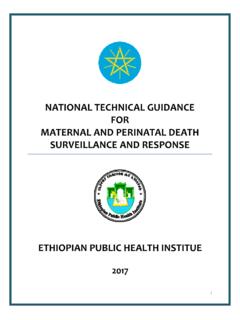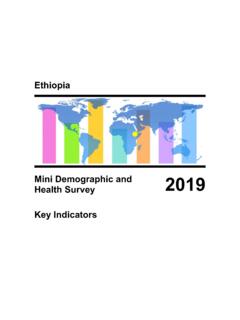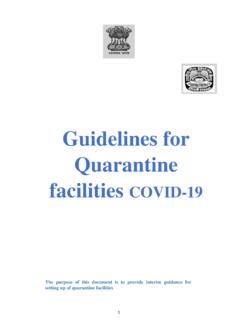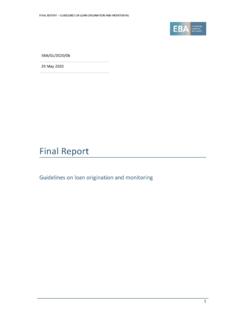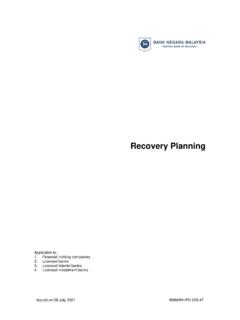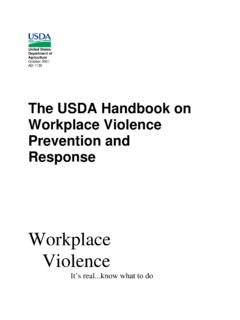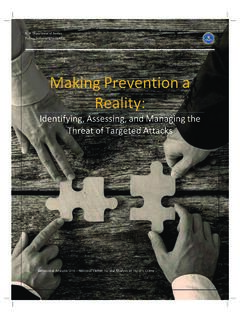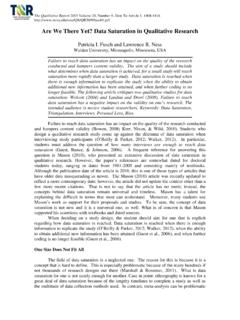Transcription of PHEM Guideline Final - Ethiopian Public Health Institute
1 Public Health Emergency Management Public Health Emergency Management Guidelines for Ethiopia 2012 Federal Democratic Republic of Ethiopia Public Health Emergency Management Ethiopian Health and Nutrition Research InstitutePublic Health Emergency Management Centre February 2012 Addis Ababa Ethiopiaublic Health Emergency Management Guidelines for Ethiopia Ethiopian Health and Nutrition Research Institute Public Health Emergency Management Centre i Table of Contents Table of Contents .. i Acronyms.
2 Iii Acknowledgements .. v Foreword ..vii SECTION 1. INTRODUCTION .. 1 Reengineering the Process .. 2 Guiding principles .. 3 Multi-hazard approach .. 3 From risk assessment to recovery .. 3 Risk assessment and mitigation .. 3 International Health Regulations (IHR2005) .. 3 Purpose of this Guideline .. 5 Scope and applicability of the Guideline .. 5 SECTION 2. Public Health EMERGENCY PREPAREDNESS .. 6 Coordination and collaboration .. 7 Vulnerability assessment and risk mapping .. 8 Assessing the impact of hazards.
3 10 Preparedness Planning .. 14 Logistics and Capacity Building .. 15 Medical and Public Health Surge .. 16 Monitoring and Simulation .. 16 SECTION 3. early WARNING AND SURVEILLANCE .. 19 Indictor Based Surveillance .. 21 Integrated Disease 22 Identifying Priority Diseases and Conditions for Surveillance .. 22 Standard Case Definitions .. 23 Reporting diseases and conditions under surveillance .. 29 Laboratory-based Surveillance .. 33 Designated Laboratories for Surveillance .. 34 Improve Local Laboratory Capacity for Surveillance and Response.
4 35 Specimen Storage and Transportation .. 36 Event-based Surveillance .. 37 Data Analysis and Interpretation .. 38 Surveillance Data Analysis and Interpretation .. 38 SECTION 4. Public Health EMERGENCY RESPONSE .. 48 Prepare for Field Work .. 51 Establish the Existence of an Outbreak .. 53 Verify the Diagnosis .. 54 Define and Identify Additional Cases .. 55 Analyze Data Collected in terms of Time, Person and Place .. 56 Develop a Hypothesis .. 59 ii Evaluate Hypotheses .. 60 Refine Hypotheses and Carryout Additional Studies.
5 62 Implement Control and Prevention Measures .. 63 Communicate Findings .. 65 SECTION 5. RECOVERY FROM Public Health EMERGENCY .. 67 Scope and Challenge .. 68 Post Emergency Assessment and its Interventions .. 70 Health system framework .. 71 Health sector PEA and analysis matrix .. 71 Using the analytical matrix for the assessment and monitoring .. 73 Managing the PEA process and its outputs .. 73 Staffing requirements and logistics for PEA Health 75 Data collection process, assessment tools, methods and indicators.
6 75 Capacity assessment .. 76 Links to other sectors and cross cutting issues .. 77 SECTION 6. MONITORING AND EVALUATION OF PHEM .. 78 Monitoring and Evaluation of PHEM preparedness .. 78 Monitoring and Evaluation of Quality of Surveillance Activities .. 79 Monitoring and Evaluation of PHE Response Activities .. 87 Monitoring and Evaluation of Recovery and Rehabilitation .. 89 SECTION 7. ANNEXES .. 91 Annex 1. Decision Instrument for Assessment and Notification of PHEIC .. 92 Annex 2. Outbreak reporting Template.
7 93 Annex 3. Checklist of laboratory supplies for use in an outbreak investigation .. 95 Annex 4. Recommended list of personal protective equipment (PPE) .. 96 Annex 5. Roles and Responsibilities of Each Level during Different Times .. 97 Annex 6. Weekly Report Form for Health Extension Workers (WRF_HEW) ..102 Annex 7. Weekly Disease Report Form for Outpatient and Inpatient Cases and Deaths (WRF) ..103 Annex 8. Daily Epidemic Reporting Format for Woreda (DERF W) ..105 Annex 9. Daily Epidemic Reporting Format for Region (DERF R).
8 106 Annex 10. Line List for Reporting form Health Facility to Woreda/Zone/Region/National and for Use during Outbreaks ..107 Annex 11. Line List for Guinea Worm and Intervention against Transmission ..108 Annex 12. Rumor Log Book of Suspected Outbreaks and / or Events ..109 Annex 13. PHEM Case based Report Form (CRF) ..110 Annex 14. Guinea Worm Case Investigation Form (CIF) ..111 Annex 15. AFP Case Investigation Form ..112 Annex 16. Case-based Laboratory Reporting Format (CLRF) ..113 Annex 17. Sample Supervisory Checklist.
9 114 Annex 18. Health Impact of Types of Disasters and Response Options ..116 Annex 19. Core Indicators and Issues by Health Sub-sectors and Health System Building Blocks 118 Annex 20. Areas and Key Questions for Capacity Assessment ..127 Annex 21. Different Disaster Phases and Assessment Approaches ..128 Annex 22. Format for Assessment of Loss in the Health Sector ..129 iii Acronyms AFP Acute flaccid paralysis AR Attack rate BOD Burden of disease BPR Business process reengineering CFR Case fatality ratio/rate CHW Community Health worker EHNRI Ethiopian Health and Nutrition Research Institute ELISA Enzyme linked immunosorbant assay EPRP Epidemic preparedness and response plan EWARS early warning and response system GIS Geographic information system HeRAMS Health resource availability mapping system HEW Health extension worker HMIS Health management information system ICT
10 Information communication technology IDS Integrated disease surveillance IHR International Health regulation MOH Ministry of Health MOU Memorandum of understanding NGO Non-governmental organizations NNT Neonatal tetanus OR Odds ratio PEA Post emergency / event assessment PF Post recovery framework PHE Public Health emergency PHEIC Public Health emergency of international concern PHEM Public Health emergency management PHEMTTF Public Health emergency management technical task force PHI Public Health intelligence PPE Personal protection equipment RR Relative risk RRT Rapid response team iv SARS Severe acute respiratory syndrome TOR Terms of reference TWG Technical working group UNICEF United Nations Childrens Fund VARM Vulnerabilityassessment and risk mapping VHF Viral hemorrhagic fever WHO World Health Organization WIR Weekly incidence rate v Acknowledgements The Ethiopian Health and Nutrition Research Institute (EHNRI)


